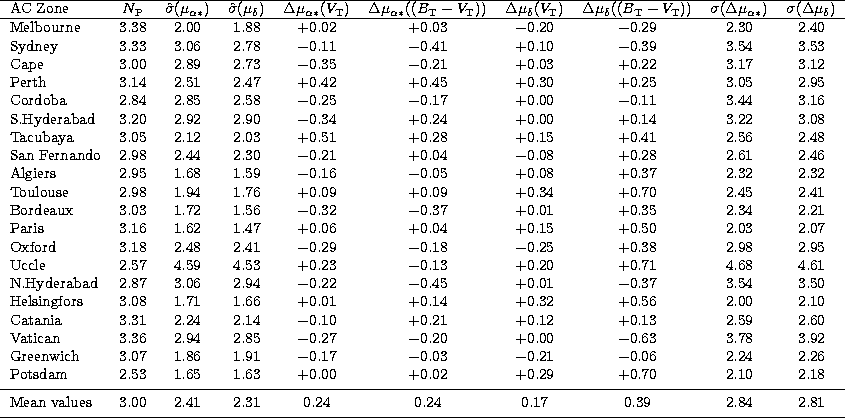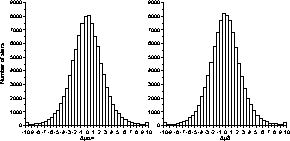
 |
(6) |
where the meaning of the various symbols is as follows: ![]() ,
,![]() - the weighted mean epochs of right ascension and declination;
- the weighted mean epochs of right ascension and declination;
![]() ,
, ![]() - the weighted means of right
ascension and declination at epoch
- the weighted means of right
ascension and declination at epoch ![]() and
and ![]() ; Ti,
; Ti,
![]() ,
, ![]() - epoch, right ascension, and declination of
the individual observation;
- epoch, right ascension, and declination of
the individual observation; ![]() and
and ![]() - resulting
proper motion components in right ascension and declination.
- resulting
proper motion components in right ascension and declination.
The individual positions were weighted by the inverse square of their respective standard errors. Those of the Tycho positions were defined by the published standard errors of right ascension and declination, while those of the AC positions were estimated from the rms scatter of the plate reduction residuals (the same for all measurements on a given plate) and estimates for the systematic errors of the individual positions, based on the covariance matrix of the plate parameters derived at step 3 of the reduction procedure (see Sect. 3). The Tycho Catalogue data is treated as one observation per star in this context.
The chi-square of the residuals after each least-squares adjustment was
compared with the expected value. Any large discrepancy indicates a problem
case due to misidentification, unresolved duplicity etc. Stars with one of
the chi-squares (for ![]() or
or ![]() ) exceeding a certain limit were
rejected. The rate of such rejections was 1.31%.
) exceeding a certain limit were
rejected. The rate of such rejections was 1.31%.
The rms internal estimates of the errors of the preliminary proper motion
components, ![]() and
and ![]() , derived from the covariance matrices of
Eqs. (6), are given in Table 3. The
estimates are provided separately for each zone to emphasize the effects of
the zonal structure of the Astrographic Catalogue, e.g. the impact of the smaller epoch
difference to the Tycho data in the AC zones covering the original Potsdam
zone. The rms all-sky
, derived from the covariance matrices of
Eqs. (6), are given in Table 3. The
estimates are provided separately for each zone to emphasize the effects of
the zonal structure of the Astrographic Catalogue, e.g. the impact of the smaller epoch
difference to the Tycho data in the AC zones covering the original Potsdam
zone. The rms all-sky ![]() and
and ![]() values for the 990 182 TRC stars are
2.37 and 2.27 mas/yr respectively. These are slightly different from the
corresponding values listed in the last row of Table 3 due
to the zonal overlaps, i.e. the one-degree declination strips on the border
of any two AC zones, covered by both of them.
values for the 990 182 TRC stars are
2.37 and 2.27 mas/yr respectively. These are slightly different from the
corresponding values listed in the last row of Table 3 due
to the zonal overlaps, i.e. the one-degree declination strips on the border
of any two AC zones, covered by both of them.
 |
In order to investigate the reliability of the internal error estimates, the
preliminary TRC proper motions were compared with those from the Hipparcos Catalogue. The
comparison was based on 93078 stars common to the two catalogues. The
distribution of the differences is shown in Fig. 8; the
standard deviations are 2.73 mas/yr in ![]() and 2.69 mas/yr in
and 2.69 mas/yr in ![]() .Comparing the latter with the rms value of the internal error estimates
(2.37/2.27 mas/yr) and taking into account rms standard error of the
Hipparcos proper motions (1.25 mas/yr per component), we conclude that the
preliminary TRC proper motions include residual systematic errors of the
order of 1 mas/yr.
.Comparing the latter with the rms value of the internal error estimates
(2.37/2.27 mas/yr) and taking into account rms standard error of the
Hipparcos proper motions (1.25 mas/yr per component), we conclude that the
preliminary TRC proper motions include residual systematic errors of the
order of 1 mas/yr.
 |
Figure 8: Differences of the preliminary TRC and Hipparcos proper motions, in units of mas/yr, based on 93078 common stars |
Probable sources of the residual systematic errors are suggested by the nature of the internal error estimates. These represent only the random errors of the individual positions and a part of the residual plate-scale systematic errors. Errors not covered by the internal estimates include:
Zonal analysis of the preliminary TRC-Hipparcos differences confirmed that the systematic errors are mainly caused by the residual magnitude equation in the AC data. Estimates of the residual magnitude and colour equations in the preliminary TRC proper motions, derived by linear interpolation from the comparison with Hipparcos, are listed in Table 3; on the average, the errors amount to 0.25 mas/yr/mag each.
It should be noted that the residual magnitude and colour equations found in
the preliminary TRC proper motions are not independent. This is explained by
the strong correlation between colour and magnitude of the Tycho Catalogue
stars: for example, if stars common to TRC and Hipparcos are divided
according to the median ![]() colour index (0.64 mag) into a "blue" and a
"red" subset, the median magnitude is
colour index (0.64 mag) into a "blue" and a
"red" subset, the median magnitude is ![]() mag for the "blue''
mag for the "blue''![]() , and
, and
![]() mag for the "red" one. Additional investigation had shown
magnitude equation to be the dominant effect, and the colour equation was
therefore ignored in the derivation of further systematic corrections.
mag for the "red" one. Additional investigation had shown
magnitude equation to be the dominant effect, and the colour equation was
therefore ignored in the derivation of further systematic corrections.
In order to derive the corrections, the differences between the preliminary
TRC and the Hipparcos proper motions for common stars were organized into a
table of ![]() and sorted according to increasing
declination. Batches of 500 successive rows of this table with 50 per cent
overlap were then used. In each batch, the stars were divided according to
and sorted according to increasing
declination. Batches of 500 successive rows of this table with 50 per cent
overlap were then used. In each batch, the stars were divided according to
![]() in two equal subsets, and the median values of the magnitude and of the
differences in proper motion components were calculated for each subset. The
magnitude equation was then assumed to be linear through the two points, but
was truncated for magnitudes brighter than
in two equal subsets, and the median values of the magnitude and of the
differences in proper motion components were calculated for each subset. The
magnitude equation was then assumed to be linear through the two points, but
was truncated for magnitudes brighter than ![]() mag to avoid large,
unwarranted corrections for very bright stars. For each batch the linear
magnitude equation estimate was calculated in the form of the intercept at
mag to avoid large,
unwarranted corrections for very bright stars. For each batch the linear
magnitude equation estimate was calculated in the form of the intercept at
![]() mag (in mas/yr) and the slope (in mas/yr/mag). These corrections
were then applied to the preliminary TRC to yield the final proper motions.
mag (in mas/yr) and the slope (in mas/yr/mag). These corrections
were then applied to the preliminary TRC to yield the final proper motions.
Copyright The European Southern Observatory (ESO)